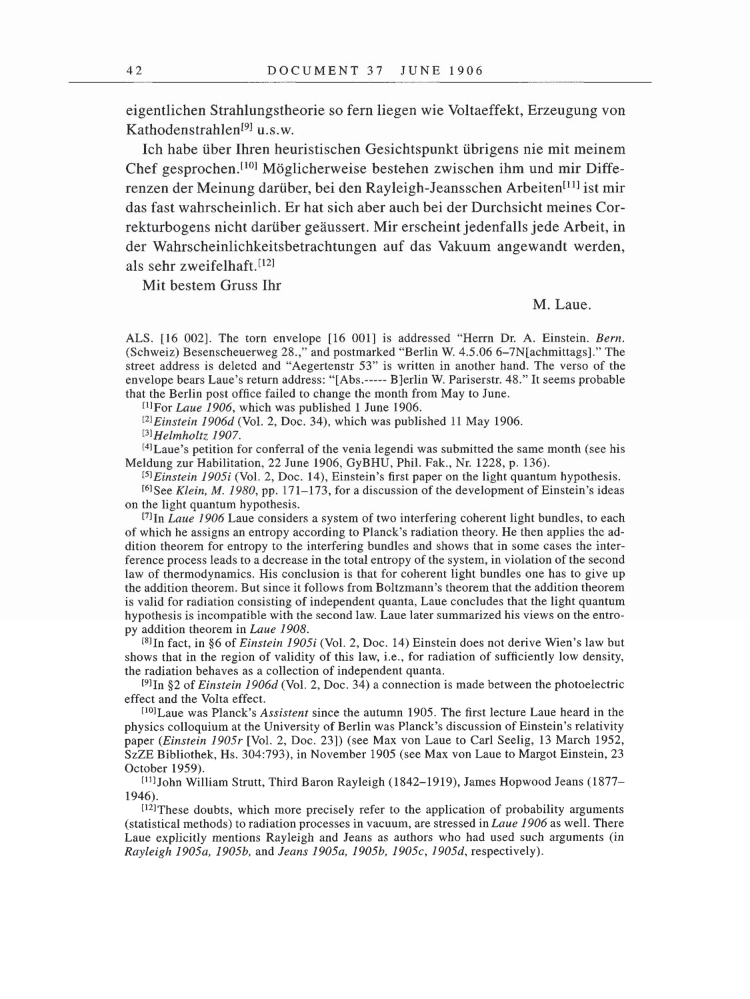42 DOCUMENT 37 JUNE 1906 eigentlichen Strahlungstheorie so fern liegen wie Voltaeffekt, Erzeugung von Kathodenstrahlen[9] u.s.w. Ich habe über Ihren heuristischen Gesichtspunkt übrigens nie mit meinem Chef gesprochen.[10] Möglicherweise bestehen zwischen ihm und mir Diffe- renzen der Meinung darüber, bei den Rayleigh-Jeansschen Arbeiten[11] ist mir das fast wahrscheinlich. Er hat sich aber auch bei der Durchsicht meines Cor- rekturbogens nicht darüber geäussert. Mir erscheint jedenfalls jede Arbeit, in der Wahrscheinlichkeitsbetrachtungen auf das Vakuum angewandt werden, als sehr zweifelhaft.[12] Mit bestem Gruss Ihr M. Laue. ALS. [16 002]. The torn envelope [16 001] is addressed "Herrn Dr. A. Einstein. Bern. (Schweiz) Besenscheuerweg 28.," and postmarked "Berlin W. 4.5.06 6-7N[achmittags]." The street address is deleted and "Aegertenstr 53" is written in another hand. The verso of the envelope bears Laue's return address: "[Abs.----- B]erlin W. Pariserstr. 48." It seems probable that the Berlin post office failed to change the month from May to June. [1]For Laue 1906, which was published 1 June 1906. [2]Einstein 1906d (Vol. 2, Doc. 34), which was published 11 May 1906. [3]Helmholtz 1907. [4]Laue's petition for conferral of the venia legendi was submitted the same month (see his Meldung zur Habilitation, 22 June 1906, GyBHU, Phil. Fak., Nr. 1228, p. 136). [5]Einstein 1905i (Vol. 2, Doc. 14), Einstein's first paper on the light quantum hypothesis. [6]See Klein, M. 1980, pp. 171-173, for a discussion of the development of Einstein's ideas on the light quantum hypothesis. [7]In Laue 1906 Laue considers a system of two interfering coherent light bundles, to each of which he assigns an entropy according to Planck's radiation theory. He then applies the ad- dition theorem for entropy to the interfering bundles and shows that in some cases the inter- ference process leads to a decrease in the total entropy of the system, in violation of the second law of thermodynamics. His conclusion is that for coherent light bundles one has to give up the addition theorem. But since it follows from Boltzmann's theorem that the addition theorem is valid for radiation consisting of independent quanta, Laue concludes that the light quantum hypothesis is incompatible with the second law. Laue later summarized his views on the entro- py addition theorem in Laue 1908. [8]In fact, in §6 of Einstein 1905i (Vol. 2, Doc. 14) Einstein does not derive Wien's law but shows that in the region of validity of this law, i.e., for radiation of sufficiently low density, the radiation behaves as a collection of independent quanta. [9]In §2 of Einstein 1906d (Vol. 2, Doc. 34) a connection is made between the photoelectric effect and the Volta effect. [10]Laue was Planck's Assistent since the autumn 1905. The first lecture Laue heard in the physics colloquium at the University of Berlin was Planck's discussion of Einstein's relativity paper (Einstein 1905r [Vol. 2, Doc. 23]) (see Max von Laue to Carl Seelig, 13 March 1952, SzZE Bibliothek, Hs. 304:793), in November 1905 (see Max von Laue to Margot Einstein, 23 October 1959). [11]John William Strutt, Third Baron Rayleigh (1842-1919), James Hopwood Jeans (1877- 1946). [12]These doubts, which more precisely refer to the application of probability arguments (statistical methods) to radiation processes in vacuum, are stressed in Laue 1906 as well. There Laue explicitly mentions Rayleigh and Jeans as authors who had used such arguments (in Rayleigh 1905a, 1905b, and Jeans 1905a, 1905b, 1905c, 1905d, respectively).
